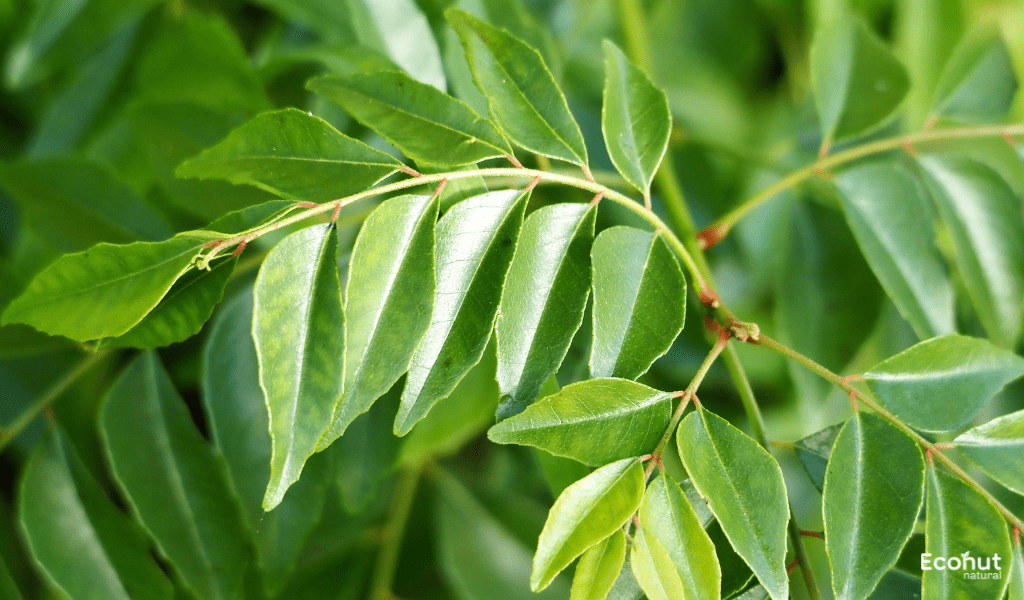In Indian cooking, curry leaves ( Murraya koenigii) are a common natural flavoring component. It infuses your cuisine with a delicious scent. Curry Leaves’ natural flavor enhances the nutritional value and flavor of your dish. The curry tree is indigenous to Sri Lanka and India. According to botany, the leaves are categorized as Murraya Koenigii and are part of the Rutaceae family.
Curry leaves, which are rich in beta-carotene and vitamin C, are powerful antioxidants that can prevent many ailments, including heart disease and diabetes. Curry leaves have a delicious, tangerine-like flavor that is often utilized in south Indian cuisine.
Description
Curry trees can reach heights of 4–6 cm, and their pungent, green leaves are paired with a white blossom that exhibits self-pollination. Curry leaflets are 2-4 cm long and 1-2 cm wide in each leaflet.
Botanical Name:
Murraya koenigii
Family:
Rutaceae
Leaves:
Shrub growing to a height of 2.5 meters Complicated, irregularly pinnate, 30-centimeter-long leaves consist of 11–21 glossy, deep green, lance-shaped leaflets.
Flowers:
All year long, the curry tree has tiny, fragrant, white blooms. These flowers have the ability to self-pollinate and usually develop in clusters.
Fruit:
The berries give the tree a vibrant appearance. They grow in clusters of 20 to 25 fruits that are linked to bright green spreading stems.
Bark and Stem:
Curry tree bark and stems are not utilized in cooking; they are usually brown or grayish-brown in color.
Habitat:
Commercial plantations have been established in Australia and India in recent times. It prefers full sun or partial shade, well-drained soil that doesn’t become dry, and a wind-free location.
Parts Used:
- Leaves
Chemical Constituents
Alkaloids, such as mahanimbine, mahanineoenimbine, murrayanol, O-methylmurrayamine A, isomahanine, bismahanine O-methylmahanine, and bispyrayafoline, are found in curry tree leaves.
Other Language Names of Curry Leaves, (Murraya koenigii)
Tamil name – Kariveppilai
Marathi name – Kadi Patta
Hindi name – Karipatta
Telugu name – Karivepaku
Kannadaname – Karibevu
Scientific Classification
| Kingdom | Plantae |
| Subkingdom | Tracheobionta |
| Superdivision | Spermatophyta |
| Division | Magnoliophyta |
| Class | Magnoliopsida |
| Subclass | Rosidae |
| Order | Sapindales |
| Family | Rutaceae |
| Genus | Murraya |
| Species | M. koenigii |
Curry Leaves, (Murraya koenigii) uses
Herbal Tea:
Herbal tea can be made with curry leaves. A fragrant and healthful tea can be made by boiling fresh curry leaves in water and then filtering the beverage. Some find it enjoyable because of the possible health advantages.
Hair Care:
Curry leaves are applied topically as a hair tonic in various cultures. It is said that infusing coconut oil with curry leaves and applying the resulting infused oil to the scalp will promote hair growth, delay the onset of gray hair, and provide nourishment to the hair.
Culinary Use:
Curry leaves are frequently used to enhance the flavor of food in Indian cooking. They are frequently used in rice dishes, chutneys, stews, curries, and many other savory meals. They give off a distinct perfume and flavor that is somewhat lemony, fragrant, and evocative of curry spices.
Curry Leaves, (Murraya koenigii) Benefits
Improves Digestion:
By promoting gastrointestinal health, lowering indigestion, and increasing digestive enzymes, these leaves help in digestion. They can aid in the relief of conditions including diarrhea and constipation.
Curry Leaves for Liver:
Research on curry leaves revealed that the leaves’ tannins and carbazole alkaloids had potent hepato-protective qualities. Additionally, it’s extremely potent anti-oxidative property not only prevents but also activates the organ to work more effectively when paired with vitamins A and C.
Treats Diabetes:
Curry leaves’ hypoglycemic characteristic is largely responsible for lowering the body’s blood sugar levels. When curry leaves are consumed, the pancreatic β-cells begin to actively produce insulin. It contributes to lower blood glucose levels by slowing the conversion of starch to glucose.
Aid in weight loss:
Mahanimbine, an alkaloid found in curry leaves, has anti-obesity properties. It also aids in the reduction of triglycerides, bad cholesterol, and lipids in your body. This in the end aids with weight management. To do this, mix five grams of curry leaf powder with a cup of warm water, and drink it first thing in the morning on an empty stomach.
Contains antioxidants:
Curry Patta contains antioxidants that protect the body from free radicals that damage cells. Almost every illness has some degree of oxidative damage or infection at some stage. Kari Patta contains compounds called carbazole alkaloids, which have antibacterial, anti-inflammatory, and antioxidant properties.
Full of Proteins:
Curry leaves are high in proteins, which are considered the building blocks of the body. It is essential to the body’s growth and development and supports the health of our immune systems.
Promoting healthy skin:
Curry leaves are a great source of vitamins, minerals, and antioxidants. These nutrients lessen inflammation, fight oxidative stress, and shield the skin from harm from free radicals. Curry leaves also have antibacterial qualities that can aid in preventing acne and other skin diseases.
Also Read: Slippery Elm – Benefits, Uses & Side Effects
Curry Leaves, (Murraya koenigii) Side Effects
Allergy:
Curry leaves may cause allergies in certain persons. Curry leaves may trigger an allergic reaction more frequently in people who have asthma or who are allergic to plant pollen. An allergic reaction to curry leaves can cause a variety of symptoms, such as sneezing, itching ears or nose, headache, mouth tingling, indigestion, skin rash, shortness of breath, difficulty breathing, and even anaphylaxis.
Blood sugar:
Curry leaves may have hypoglycemic properties. For those who have diabetes, this may be helpful, but if you take blood sugar-lowering medicine, it may also result in hypoglycemia, or low blood sugar.
Pregnancy and breastfeeding:
Information regarding curry leaves’ safety for pregnant or nursing mothers is insufficient. During these circumstances, it’s advisable to err on the side of caution and refrain from taking big amounts of curry leaves.
Conclusion
Curry leaves, valued for their unique flavor and fragrance in Indian cooking, have a complex nutritional profile that makes them potentially beneficial for a variety of health conditions. These leaves are prized for their culinary variety as well as their traditional medical benefits, which include improving digestion, strengthening hair, and having anti-inflammatory qualities. Although the holistic benefits of Ayurveda are well acknowledged, further empirical research is required to fully support these claims. Nevertheless, curry leaves remain a delectable herb with promise wellness qualities, beckoning investigation in both culinary delights and holistic well-being, whether used to improve the taste of dishes, in herbal teas, or as a potential health aid.
FAQS
What advantages do Curry leaves offer?
Curry leaves fragrant flavor makes it a popular ingredient in cooking. It is high in vitamins and used as an analgesic, carminative, and to cure stomachaches. Because to the inclusion of bioactive substances including carbazole alkaloid, it possesses anti-inflammatory, antioxidant, and anticancer activities
What is the purpose of Curry leaves in medicine?
Curry leaves green leaves are used to treat edema, bruising, diarrhea, inflammation, itching, piles, and fresh cuts. The roots have some purgative properties. They are used to treat typical body aches and are invigorating.
What adverse consequences might curry leaves cause?
Curry leaves’ high fiber content can be beneficial to the stomach. Nevertheless, consuming too much fiber could make you feel nauseous. Constipation, diarrhea, cramping in the stomach, and bloating could result from it.

